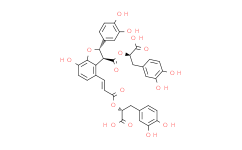| 中文名称: | 丹酚酸B | ||||
|---|---|---|---|---|---|
| 英文名称: | Salvianolic acid B | ||||
| 别名: | 丹酚酸B Lithospermic acid B | ||||
| CAS No: | 121521-90-2 | 分子式: | C36H30O16 | 分子量: | 718.61 |
| CAS No: | 121521-90-2 | ||||
| 分子式: | C36H30O16 | ||||
| 分子量: | 718.61 | ||||
包装规格:
20mg in glass bottle
产品简介:
是一种丹参的重要组分,它常用来研究微循环疾病。
溶解性:
溶于DMSO(25 mg/mL 超声)
储备液保存:
该产品在溶液状态不稳定,建议您现用现配,即刻使用。
体内实验:
1、请依序添加每种溶剂: PBS
Solubility: 50 mg/mL (69.58 mM); Clear solution; Need ultrasonic
2、请依序添加每种溶剂: 10% DMSO→40% PEG300→5% Tween-80→45% saline
Solubility: ≥ 2.5 mg/mL (3.48 mM); Clear solution
此方案可获得 ≥ 2.5 mg/mL (3.48 mM,饱和度未知) 的澄清溶液。
以 1 mL 工作液为例,取 100 μL 25.0 mg/mL 的澄清 DMSO 储备液加到 400 μL PEG300 中,混合均匀;向上述体系中加入50 μL Tween-80,混合均匀;然后继续加入 450 μL生理盐水定容至 1 mL。
3、请依序添加每种溶剂: 10% DMSO→90% (20% SBE-β-CD in saline)
Solubility: ≥ 2.5 mg/mL (3.48 mM); Clear solution
此方案可获得 ≥ 2.5 mg/mL (3.48 mM,饱和度未知) 的澄清溶液。
以 1 mL 工作液为例,取 100 μL 25.0 mg/mL 的澄清 DMSO 储备液加到 900 μL 20% 的 SBE-β-CD 生理盐水水溶液中,混合均匀。
4、请依序添加每种溶剂: 10% DMSO→90% corn oil
Solubility: ≥ 2.5 mg/mL (3.48 mM; Clear solution
此方案可获得 ≥ 2.5 mg/mL (3.48 mM,饱和度未知) 的澄清溶液,此方案不适用于实验周期在半个月以上的实验。
以 1 mL 工作液为例,取 100 μL 25.0 mg/mL 的澄清 DMSO 储备液加到 900 μL玉米油中,混合均匀。
<1mg/ml表示微溶或不溶。
普西唐提供的所有化合物浓度为内部测试所得,实际溶液度可能与公布值有所偏差,属于正常的批间细微差异现象。
请根据产品在不同溶剂中的溶解度选择合适的溶剂配制储备液;⼀旦配成溶液,请分装保存,避免反复冻融造成的产品失效。
Solubility: 50 mg/mL (69.58 mM); Clear solution; Need ultrasonic
2、请依序添加每种溶剂: 10% DMSO→40% PEG300→5% Tween-80→45% saline
Solubility: ≥ 2.5 mg/mL (3.48 mM); Clear solution
此方案可获得 ≥ 2.5 mg/mL (3.48 mM,饱和度未知) 的澄清溶液。
以 1 mL 工作液为例,取 100 μL 25.0 mg/mL 的澄清 DMSO 储备液加到 400 μL PEG300 中,混合均匀;向上述体系中加入50 μL Tween-80,混合均匀;然后继续加入 450 μL生理盐水定容至 1 mL。
3、请依序添加每种溶剂: 10% DMSO→90% (20% SBE-β-CD in saline)
Solubility: ≥ 2.5 mg/mL (3.48 mM); Clear solution
此方案可获得 ≥ 2.5 mg/mL (3.48 mM,饱和度未知) 的澄清溶液。
以 1 mL 工作液为例,取 100 μL 25.0 mg/mL 的澄清 DMSO 储备液加到 900 μL 20% 的 SBE-β-CD 生理盐水水溶液中,混合均匀。
4、请依序添加每种溶剂: 10% DMSO→90% corn oil
Solubility: ≥ 2.5 mg/mL (3.48 mM; Clear solution
此方案可获得 ≥ 2.5 mg/mL (3.48 mM,饱和度未知) 的澄清溶液,此方案不适用于实验周期在半个月以上的实验。
以 1 mL 工作液为例,取 100 μL 25.0 mg/mL 的澄清 DMSO 储备液加到 900 μL玉米油中,混合均匀。
<1mg/ml表示微溶或不溶。
普西唐提供的所有化合物浓度为内部测试所得,实际溶液度可能与公布值有所偏差,属于正常的批间细微差异现象。
请根据产品在不同溶剂中的溶解度选择合适的溶剂配制储备液;⼀旦配成溶液,请分装保存,避免反复冻融造成的产品失效。
靶点:
SIRT
体外研究:
Salvianolic acid B (SA-B) 1 and 10 micromol/L decrease the cell active TGF-beta1 secretion by 63.3 % and 15.6 % of the control, down-regulat pro-collgen alpha1(I) mRNA expression to 77.0% and 51.8% respectively (P<0.05). SA-B 1 and 10 micromol/L also inhibit MAPK activity by 1 to 2 fold respectively.
The degradation of Salvianolic acid B is temperature dependent. It was stable at 4ºC for 30 h in aqueous solution. However, decomposition of Salvianolic acid B aqueous solution occurres automatically at 25ºC, and is enhanced at 37, 65 and 100ºC. On the other hand, Salvianolic acid B is also stable at 4, 25 and 37ºC for 30 h in TPA (total phenolic acids).
Salvianolic acid B is stable for 30 h in buffered phosphate aqueous solutions at pH 1.5, 3.0 and 5.0. With an increase of pH from the neutral, the stability of Sal B decreased.
The degradation of Salvianolic acid B is temperature dependent. It was stable at 4ºC for 30 h in aqueous solution. However, decomposition of Salvianolic acid B aqueous solution occurres automatically at 25ºC, and is enhanced at 37, 65 and 100ºC. On the other hand, Salvianolic acid B is also stable at 4, 25 and 37ºC for 30 h in TPA (total phenolic acids).
Salvianolic acid B is stable for 30 h in buffered phosphate aqueous solutions at pH 1.5, 3.0 and 5.0. With an increase of pH from the neutral, the stability of Sal B decreased.
体内研究:
Salvianolic acid B (SalB) (5 mg · kg-1 · h-1) significantly attenuates LPS-induced pulmonary microcirculatory disturbance, including the increase in leukocyte adhesion and albumin leakage. In addition, LPS increases pulmonary tissue wet-to-dry weight ratio and tumor necrosis factor [alpha] and interleukin 8 levels in plasma and bronchoalveolar lavage fluid enhances the expression of E-selectin, intercellular adhesion molecule 1, myeloperoxidase, MMP-2, and MMP-9, whereas it decreases the expression of AQP-1 and AQP-5 in pulmonary tissue, all of which are attenuated by SalB pretreatment[1]. SalB administration (10 mg/kg) significantly ameliorate the Aβ25-35 peptide-induced memory impairment in the passive avoidance task (P<0.05). SalB treatment also reduced the number of activated microglia and astrocytes that are observed during the inflammatory reaction after the administration of the Aβ25-35 peptide. Moreover, SalB markedly reduce inducible nitric oxide synthase and cyclooxygenase-2 expression levels and thiobarbituric acid reactive substances, which are increased by the administration of the Aβ25-35 peptide. Furthermore, SalB administration significantly rescue the Aβ25-35 peptide-induced decrease of choline acetyltransferase and brain-derived neurotrophic factor protein levels.
细胞实验:
细胞系:人肝癌细胞HepG2
浓度:8 μM
孵育时间:3 h
方法:将HepG2细胞培养在含10% FBS的MEM培养基中,使其在37℃、5% CO2的细胞培养箱中孵育。将细胞以1×105 cells/well的密度接种,并生长24小时。然后用8 μM SalB处理3小时或10 mM Ex527或RES处理6小时。处理过后,将细胞暴露于100 mM的乙醇中48小时。
浓度:8 μM
孵育时间:3 h
方法:将HepG2细胞培养在含10% FBS的MEM培养基中,使其在37℃、5% CO2的细胞培养箱中孵育。将细胞以1×105 cells/well的密度接种,并生长24小时。然后用8 μM SalB处理3小时或10 mM Ex527或RES处理6小时。处理过后,将细胞暴露于100 mM的乙醇中48小时。
动物实验:
Animal Models:Sprague-Dawley雄性大鼠
Dosages:15 或 30 mg/kg/d
Administration:灌胃
Dosages:15 或 30 mg/kg/d
Administration:灌胃
注意事项:
1、为了您的安全和健康,请穿实验服并戴一次性手套操作。
2、以上信息仅做参考交流之用。
2、以上信息仅做参考交流之用。
保存条件:
-20℃
UN码:
HazardClass:
危害声明:
安全说明:
搜索质检报告(COA)
参考文献 & 客户发表文献
本计算器可帮助您计算出特定溶液中溶质的质量、溶液浓度和体积之间的关系,公式为:
质量 (g) = 浓度 (mol/L) x 体积 (L) x 分子量 (g/mol)
摩尔浓度计算公式
用本工具协助配置特定浓度的溶液,使用的计算公式为:
开始浓度 x 开始体积 = 最终浓度 x 最终体积
稀释公式
稀释公式一般简略地表示为:C1V1 = C2V2 ( 输入 输出 )








